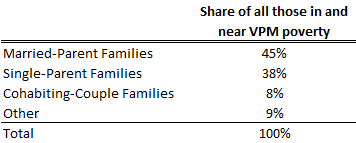Will promoting marriage solve childhood poverty in Virginia?

In 2011, one in three Virginia children lived in economic insecurity–either in poverty or in near poverty–as defined by Virginia Poverty Measure (VPM) poverty thresholds. This statistic, among others, is discussed in depth in the Cooper Center’s newest paper, New Insights on Childhood Poverty: A Deeper Look into the Results from the Virginia Poverty Measure.
Slightly more than 13 percent of Virginia kids lived in poverty, according to the VPM. Another 18.5 percent lived beyond poverty, but below 150% of the VPM poverty thresholds. To put this into perspective, a two-adult, two-child family in Virginia with annual resources between $29,000 and $43,000 lives in near-poverty, while the same family living with resource totals below $29,000 would be considered in poverty under the VPM.*
Given the attention that marriage often receives from both pundits and policymakers as a a strategy to address childhood poverty, the paper released today focuses on the marital status of parents, comparing poverty and near-poverty across three groups: married-parent families, cohabiting-parent families, and single-parent families. Our findings reinforce some common understandings of childhood poverty while also illuminating some of its less-frequently-discussed realities.
Namely, while it is true that children in single- and cohabiting-parent** households experience economic insecurity at higher rates than married-parent kids, nearly half of Virginia children living in economic insecurity live in a home with married parents. This is because nearly 70 percent of Virginia children live in married-parent homes.


Marriage is often portrayed as a low-cost, high-reward mechanism for fighting poverty. Married parents, it is commonly argued, provide the best economic environment for kids. At the same time, many question or critique marriage-as-anti-poverty-policy from both political and empirical standpoints.
The reality in Virginia–that nearly half of the economically insecure children live with married parents–calls into question how much attention marriage promotion should merit. New Insights on Childhood Poverty: A Deeper Look into the Results from the Virginia Poverty Measure not only offers a detailed descriptive analysis of childhood poverty and family structure, but also suggests an array of anti-poverty initiatives that will benefit all poor and near-poor children, irrespective of the marital status of their parents.
*These are average dollar values– the precise amounts differ by region.
**Cohabiting adults are those who live with an unmarried partner. The cohabiting partner of a child’s parent may or may not be a child’s second parent.


